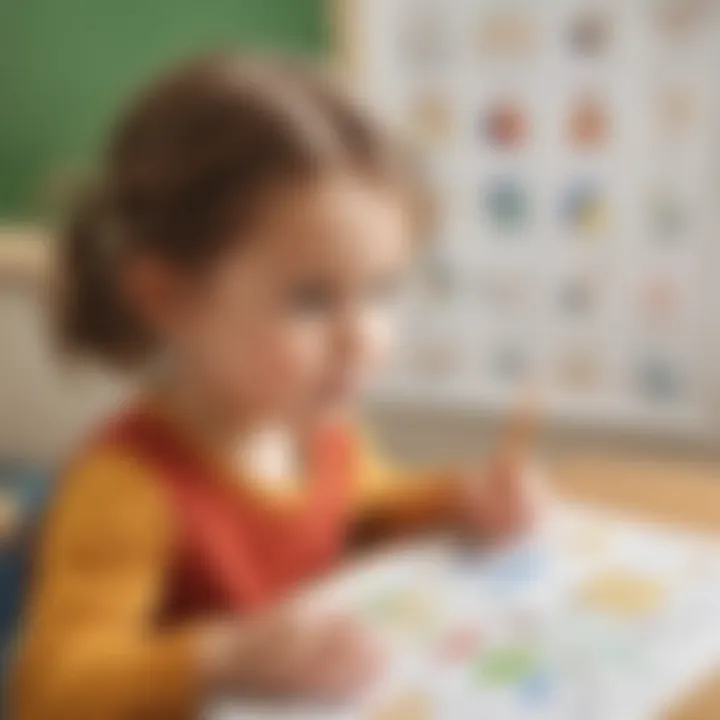Learning Sheets for Three-Year-Olds: A Comprehensive Guide


Intro
Understanding early childhood education is essential for parents, caregivers, and educators. Among various tools available, learning sheets have shown considerable value. They help in promoting cognitive and social growth in young children, particularly those around three years of age. By creating a structured yet delightful environment, learning sheets provide hands-on interactions that nurture curiosity.
In this guide, we explore concepts such as the benefits of these materials and methods of effective use in daily routines. You will also find creative activity ideas, engaging quizzes, and fact-driven articles tailored for three-year-olds. Preparation for an enriching learning experience starts with these engaging resources. Moreover, discovering easy ways to integrate these exercises into children's playtime creates an enjoyable atmosphere for learning.
Creative Activities
The incorporation of creative activities in learning sheets greatly enhances a child's educational journey. Children at this age benefit from play-based learning, as it plays a key role in their cognitive development. Below are some segments that illuminate this section.
Craft Ideas
Engaging in craft activities enables children to tap into their creativity. Simple items such as colored paper, glue, and safety scissors can be utilized effectively. Activities like making a collage or decorating a simple paper bag can inspire excitement.
Step-by-Step Guides
- Collage Making: Gather various magazines. Ask the child to search for colorful images, cut them out, and assemble a personal collage.
- Paper Plate Animals: Use paper plates to create different animal faces. Paint or color and attach ears or tail for added fun.
- Nature Frames: Collect small twigs or leaves and paste them around a border for a nature-themed frame.
These activities not only strengthen motor skills but allow children to express themselves clearly.
Educational Value
Crafts often teach children about shapes, colors, and textures. Each creative project often embeds lessons subtly within it, such as the importance of taking turns when sharing materials. Children 'learn by doing.' Consequently, this impact enriches their love for discovery and critical thought.
Fun Quizzes
Quizzes serve as a fun yet educational experiences, providing formative assessments of children's knowledge.
Quiz Topics
Quizzes on topics may include:
- Colors and Shapes
- Numbers and Counting
- Animals and Their Sounds
- Simple Word Recognition
These quizzes help appropriate retention of knowledge, allowing children to validate their understanding in a playful manner.
Question Types
Question types can range from multiple-choice to images where kids choose the right answer, ensuring high engagement. They also can include fill-in-the-blanks, and pictorial representations which further enhances relatability.
Knowledge Reinforcement
Doing quizzes serves to consolidate knowledge. Regular interaction with quizzes allows for active learning, benefitting retention of new knowledge early on.
Fact-Based Articles
Fact-based articles function as informative tools, expanding children’s knowledge about the world around them.
Topics
Topics might span:
- Dinosaurs
- Outer Space
- The Ocean
- Weather Effects
Engaging Content
By presenting content in a simple yet rich format, these articles demand children's attention through imaginations. Clear headers, supportive visuals, and accessible vocabulary enhance retention. As children experience structured content, they develop important literacy skills.
Understanding Early Childhood Education
Understanding early childhood education is a vital step in grasping how learning sheets benefit three-year-old childr3en. At this age, kids start to engage with their environment more actively. Emerging educational tools, like learning sheets, become instrumental regarding this discovering process. They present opportunities for skills development that form building blocks for later learning.
Importance of Early Learning
Early learning sets the direction for cognitive growth in children. This phase influences a child’s social, emotional, and physical development. Early educational experiences can shape attitudes towards schooling. Learning sheets foster long-lasting foundational knowledge while aiding essential studies.
Engaging with learning sheets allows children to practice recognition of shapes, letters, and numbers. Through interactions with these materials, a child builds an understanding that will serve them later. Moreover, research supports that quality early learning experiences significantly impact a child's future education);


- It helps build a desire for exploration.
- Promotes a love for learning that transcends basic subjects.
- Children learn through diverse activities rather than passive listening.
Cognitive Development in Preschoolers
Around the age of three, cognitive abilities begin to mature in marked ways. This period reveals vast development potentials and enhance brain plasticity. Learning sheets enhance various cognitive skills, such as problem-solving, memory retention, and logical reasoning. They offer engaging ways to introduce concepts like math or reading, effectively transforming abstract ideas into tangible experiences.
While working on tasks like puzzles or tracing activities, children improve concentration and develop memory skills. This cognitive groundwork is integral to their continual learning journeys. Also, it lays important social skills. Collaboration with peers teaches three-year-olds lessons in negotiation, sharing, and constructive engagement stiffened by early, guided experiences.
Role of Play in Learning
Play provides a foundational mark in early learning approaches. Quality raw play is often undervalued formally. However, outcomes show it strengthens children’s open-ended thinking and creativity. Learning sheets encourage this dynamic; they imbue foundational skills alongside fun means.
Consider this; through creative interaction with educational sheets, toddlers can practice important attributes like curiosity and initiative. Engaging them in play-like worksheets nurtures their imagination further. Here they not only learn facts but create stories or explore solutions, allowing cognitive gains to flourish in naturally engaging settings.
“Play is not only our creative and fun range; it is our highest form of research,” – Albert Einstein.
In summary, early childhood education blossoms in rich environments filled with engaging opportunities. Learning sheets serve as one mode of approach equipping three-year-olds with essential lifelong skills.
Learning Sheets: An Overview
Learning sheets play a critical role in the early educational experience of three-year-olds. When utilized effectively, these sheets can make a significant impact on various aspects of a child's development. Understanding what learning sheets are and what types exist provides caregivers and educators with valuable insights for maximizing their use.
Definition and Purpose
Learning sheets refer to printed or digital resources aimed at teaching specific skills to children. For three-year-olds, the purpose of these materials is centered around nurturing skills like fine motor abilities, cognitive development, and independence. Learning sheets serve several key objectives: engaging young minds, and fostering curiosity, and enhancing their capacity to learn through structured activities. Each resource can help lay a foundation for future academic success by introducing basic concepts in a way that is accessible and enjoyable for young children.
Types of Learning Sheets
Learning sheets can be categorized into various types, each bringing distinct advantages for young learners. The diverse nature of these sheets caters to different developmental needs and preferences of preschoolers.
Coloring Sheets
Coloring sheets are not only entertaining but also functional. They encourage creativity while improving fine motor skills. Working with crayons or markers helps children develop control over writing utensils, which is crucial for later stages of writing. The engaging aspect of choosing colors fosters decision-making and these activities can easily captivate a child's attention. The simple premise of coloring does not overwhelm, allowing even the youngest children to enjoy this mental stimulation. One possible downside is that they may not always engage a child's cognitive skills as much as more interactive options.
Tracing Worksheets
Tracing worksheets provide a structured approach to learning. They ofered children the opportunity to replicate shapes, numbers, or even letters. This practice reinforces fine motor skills and hand-eye coordination. Moreover, repeating these motions signals to the brain, helping with memory retention related to each shape or letter, enhancing literacy at an early age. While they provide directed engagement, some children may find tracing less interesting than other activities, which could lead to moments of disengagement.
Matching Activities
Matching activities encourage in-depth cognitive skills. Through the process of pairing similar objects, images, or concepts, children exercise memory and association. This capability to match fosters early problem-solving skills. Matching also enables social interaction when done in groups, promoting collaboration. Some potential challenges include the necessity for adult supervision to guide children through the correct matching process and address questions as they arise.
Simple Puzzles
Simple puzzles facilitate critical thinking and spatial reasoning. By manipuulating pieces, children learn the concepts of shape and fit, providing a solid introduction to problem-solving. Having engaging visuals for simple puzzle designs enhances attraction and interest. Hours of fun are possible with simple, colorful puzzles. Nonetheless, patience can wane when children cannot find the right fit immediately.
Learning sheets are essential to early childhood education as they promote key developmental skills through engagement and exploration.
Through various types of learning sheets, caregivers can understand how important it is to provide activities that stimulate different aspects of early learning for three-year-olds. Integration in their daily routine nurtures love for learning that can positively influence their educational journey ahead.
Benefits of Learning Sheets for Three-Year-Olds
Learning sheets have become essential tools in early childhood education, especially for three-year-olds. This age marks a period of rapid development in several areas, including physical skills, cognitive abilities, and social understanding. Learning sheets serve as a bridge between fun and education, enhancing different skills necessary for a child's growth.
Enhancing Fine Motor Skills
Fine motor skills involve the use of small muscles in the hands and fingers. These skills are crucial for tasks like writing, buttoning clothing, or tying shoelaces. Engaging with learning sheets provides children the opportunity to practice and refine these skills. Tracing shapes or connecting dots requires controlled movements of the hand, giving practice to young learners.
- Types of Activities: Activities including coloring and tracing demand precision. Children must hold crayons or pencils, which strengthens grip.
- Building Confidence: Each successful attempt will boost their confidence. Making new shapes and letters successfully leads to pride in their work, encouraging further attempts.
Simplifying activities helps keep children from becoming overwhelmed. Children can experience small wins, setting a solid foundation for more in-depth tasks as they grow.
Encouraging Independence
Independence is a valuable trait that develops in early childhood. Learning sheets encourage three-year-olds to take initiative and figure out tasks on their own. Instead of relying heavily on adult guidance, they learn to make decisions.
- Self-guided Exploration: Children often view learning sheets as personal achievements. Completing tasks without constant help fosters a sense of autonomy.
- Problem-solving Skills: Through these sheets, kids encounter challenges. Simple exercises often lead to shifting bit of logic; when kids recognize patterns or know to color within lines, they adapt their approaches.
Encouraging independence helps children become more self-reliant. It provides them the confidence to tackle new problems and boosts belief in their own experiences.


Building Cognitive Skills
Cognitive development lays the groundwork for future learning. Using learning sheets helps in enhancing key areas of cognitive growth. These include memory, reasoning, and language comprehension. During this important stage, engaging with well-designed learning materials yields considerable cognitive benefits.
- Problem-solving: Working on activities that require sorting, matching, or completing puzzles stimulates the child's brain and encourages exploration.
- Language Development: Describing actions taken while engaging with sheets facilitates vocabulary expansion. It turns simple tasks into attractive language learning experiences.
Ultimately, these cognitive skills become essential in the later years of formal education. Learning sheets can be seen not merely as activities but tools shaping minds early on.
The importance of integrating playful methods in education cannot be understated. For three-year-olds, every interaction with material counts.
Fostering growth in fine motor skills, independence, and cognitive skills all points to a more robust learning experience for three-year-olds. As children engage with learning sheets, they develop various necessary skills that get them ready for more complex educational demands.
Effective Use of Learning Sheets
The effective use of learning sheets plays a crucial role in the educational journey for three-year-olds. These sheets, when utilized appropriately, serve as powerful tools that aid in a child's cognitive and motor skill development. Understanding how to integrate these resources into daily life enhances their learning experience. Moreover, employing learning sheets thoughtfully can substantially boost engagement and motivation.
Incorporating Learning Sheets in Daily Routine
Integrating learning sheets into the daily routine of a three-year-old can facilitate consistency in learning without overwhelming the child. This integration should be straightforward and enjoyable enough for children to look forward to the activity.
Consider setting aside specific times of day where learning sheets become part of the routine. For example:
- Morning Transitions: Before breakfast, a short 10-minute activity focusing on colors or shapes can set a positive tone for the day.
- Pre-nap Calm Down: After lunch, use simpler sheets, like coloring or tracing, as a calming pre-nap activity.
- Evening Reflections: Sharing what they learned or created on learning sheets can make evenings valuable opportunities for conversation and bonding.
Regularly revisiting and mixing the types of learning sheets keeps children engaged and interested.
Tips for Engaging Children
Engagement during learning sheet activities is fundamental to ensuring a productive experience. Children at this age often have short attention spans. Therefore, following these tips can encourage participation:
- Choose Relevant Themes: Tailoring sheets to children's current interests can increase their willingness to participate. For example, if a child loves animals, incorporating animal-themed learning sheets can excite them.
- Use Varied Activities: Constantly switch between activities such as coloring, matching, and simple puzzles to hold their attention.
- Allow Creativity: Encouraging open-ended projects gives children the freedom to express themselves, resulting in deeper engagement.
- Participate Together: Adults joining in on the learning session can provide support and encouragement. Modeling enthusiasm for the activities can make the experience more enjoyable.
Monitoring Progress
Keeping track of a child's progress with learning sheets is important to identify their strengths and areas that might need more focus. Monitoring can be both informal and structured:
- Create a Portfolio: Collect completed sheets in a folder, which offers a tangible way to see improvement.
- Set Milestones: Establish small milestones to give children achievable goals, such as completing a particular number of sheets each week.
- Reflect Together: Periodically discuss what they have learned or created. This not only reinforces learning but allows educators to gauge understanding.
Regular reflection helps not only to celebrate achievements but also to pinpoint areas needing extra practice.
By integrating these suggestions into daily activities with learning sheets, caregivers can nurture an enriching early education experience while ensuring developmental goals are being met.
Creating Customized Learning Sheets
Creating customized learning sheets plays a critical role in early childhood education, especially for three-year-olds. The design of these materials is deeply intertwined with a child’s growth and engagement. Providing kids with personalized resources allows educators and parents to meet specific learning needs, harnessing each child’s interests and capabilities. This approach not only enhances skill acquisition but also fosters motivation and a sense of ownership in learning.
Template Resources
Choosing the right templates is essential when crafting customized learning sheets. Various online and software tools offer templates tailored for toddlers. Parents can access websites dedicated to educational resources for preschoolers, where they can find ready-made sheets and customize them. Resources such as TeacherPayTeachers and Education.com provide a variety of templates that cater to diverse learning styles and topics. Using these templates can significantly simplify the process, ensuring that learning sheets are not only engaging but also educationally sound.
Using pre-made templates saves time and effort, letting parents focus more on adjustments that best fit their children's needs. Most importantly, it lets families create learning experiences that resonate personally with their accomplishments and interests.
Design Considerations
Age Appropriateness
When designing learning sheets, age appropriateness is a fundamental aspect. This consideration ensures that the materials align with the developmental stage of three-year-olds. Activities need to be easy enough for toddlers to manage, promoting motivation rather than frustration.
A key characteristic of age-appropriate learning materials is their simplicity. Activities should encourage exploration and pre-kindergarten skills, without overwhelming the child. It benefits both children and caregivers, ensuring intended outcomes are achievable without excessive support. Additionally, suitable material content retains young children's focus, promoting active learning.
Color Choices
Color choices are also important in designing effective learning sheets. Vibrant and contrasting colors capture the attention of toddlers. Bright colors can stimulate interest and highlight essential areas of the page.
This aspect of design is advantageous because it is easily recognizable to young learners. Additionally, colors can help categorize activities or differentiate instructions among varying tasks. However, too many colors can lead to confusion. Thus, keeping a balance is key for visibility without chaos.
Complexity Levels


Lastly, considering complexity levels in learning sheets is crucial. Complexity must align with both cognitive capacity and fine motor skills of three-year-olds. Materials that are appropriately challenging can promote engagement and perseverance.
These activities must strike a balance where they introduce new concepts without triggering frustration. This niche selection fosters curiosity, and supports cognitive growth while making the overall learning experience smoother. It promotes skills like problem-solving and readiness to encounter other learning challenges as they advance.
In summary, developing customized learning sheets requires careful attention to template selection, design priorities like age relevance, ideal color utilization, and matching complexity. The result can be enriching tools that nurture growth and love for learning.
Digital Learning Sheets: A Modern Approach
In today's digital age, the integration of technology in early childhood education is increasingly prevalent. Digital learning sheets offer a modern method for engaging preschoolers, blending interactive tools with traditional learning styles. These sheets come with flexible formats that can cater to diverse learning needs and environments, enriching the educational experience for three-year-olds.
Benefits of Digital Formats
The adoption of digital learning sheets presents several advantages:
- Accessibility: Children can access learning materials on various devices, from tablets to computers. This accessibility allows for learning anywhere and any time, which fits busy family schedules.
- Engagement: Many digital learning sheets incorporate animations or sounds, capturing the attention of curious young minds. This excitement can enhance participation and motivation in learning activities.
- Interactive Learning: Through touch-screen technologies, children can engage hands-on. This makes activities more fun and allows them to explore at their own pace.
- Customization: Digital formats often offer unique ways to tailor education specifically for individual learning styles. Parents and educators can adjust the levels of complexity and interactivity.
- Instant Feedback: Many digital sheets provide immediate responses to a child's input, helping them assess their understanding in real-time.
Interactive Applications and Tools
Various apps and digital tools have emerged that focus on preschool learning:
- Educational Apps: Options like
Challenges and Considerations
Understanding the challenges and considerations around learning sheets for three-year-olds is essential for effective implementation. Parents and educators often encounter issues that can impede the intended benefits of these educational tools. Comprehending these challenges allows for informed decisions that promote beneficial learning experiences.
Overwhelm from Excess Materials
One key downside faced when using learning sheets is the overwhelming nature of having too many materials. Young children can easily become stressed or confused when presented with an abundance of options. This can result in disengagement or frustration instead of encouraging learning.
When designing activities, it's crucial to be selective in the types of learning sheets offered. Too many choices can lead to analysis paralysis, causing the child to struggle rather than enjoy learning.
To manage this:
- Focus on Quality Over Quantity: Offer a few well-designed sheets instead of a plethora of choices.
- Rotate Materials: Change sheets regularly to keep engagement high without having an excess.
- Simplify Instructions: Each learning sheet should come with clear, direct instructions. This helps a child understand what is expected without getting overwhelmed.
Balancing Structured and Unstructured Learning
Finding the right balance between structured and unstructured learning is vital. Structured learning through worksheets can provide valuable practice and repetition during skill development. However, overly focusing on this method can stifle creativity and free exploration in young children.
Unstructured play is equally important for cognitive and emotional growth. Children thrive on freedom and exploration, allowing them to experiment and discover. Striking a balance is crucial for fostering a love for learning.
For effective balance:
- Integrate Structured Sheets with Play: Combine worksheet activities with interactive play sessions that reinforce skills in a less rigid atmosphere.
- Allow Choices: Let children choose which DIY or creative activities they want to take alongside learning sheets, reinforcing self-direction.
- Be Flexible: Pay attention to your child's response to lessons. Some days, they may need more guidance; other times, they flip to independent learning. Provide support based on their mood and engagement level.
Epilogue: The Role of Learning Sheets in Early Education
Learning sheets play a crucial role in early education for three-year-olds. These resources provide structured activities that promote various aspects of a child's development. Tailored exercises help in developing fine motor skills, cognition, and problem-solving abilities. Integrating learning sheets into a child's daily routine ensures a balanced learning experience that aligns with their developmental needs.
One significant benefit of using learning sheets is their contribution to fostering a love for learning. When children engage in creative activities, they explore and discover new concepts. The satisfaction of completing a task empowers them and nurtures a positive attitude toward education.
Learning sheets can turn mundane exercises into enjoyable, exploratory activities that keep young minds engaged.
It is also essential to monitor how children interact with these sheets. Regular engagement can reveal their interests and areas where they may need more help. Likewise, it is important to consider the child’s readiness. Overwhelm from excessive materials can stunt the growth of enthusiasm and curiosity.
Thus, learning sheets should be used smartly and purposefully. Balancing between structured tasks and play provides a comprehensive educational experience that encourages holistic growth. As children progress, adapting the complexity of the tasks will ensure continued interest and challenge.
In summary, learning sheets serve as effective educational tools that can enhance early childhood learning experiences. Their vital role in developing essential skills while simultaneously cultivating a love for learning is invaluable.
Fostering a Love for Learning
Fostering a love for learning during early childhood is fundamental. Learning sheets can ignite this enthusiasm by providing inclusive learning experiences. Children learn best when they are interested and engaged. Activities found in learning sheets can vary greatly, from coloring to simple puzzles.
Additionally, these resources can cater to different tastes, ensuring that each child will find something appealing. A colorful and inviting design prompts children to nibble on knowledge. With consistent use, learning sheets enhance intrinsic motivation. Children feel pride, satisfaction, and eagerness when they complete their tasks.
Effective instructions further enhance this positive learning environment. Positive reinforcement helps children connect enjoyment with learning, they may not realize they are mastering number recognition or phonics while playing games.
Final Thoughts for Parents and Educators
For parents and educators, the key lies in supporting children as they encounter learning materials. While learning sheets are valuable, they must complement other types of learning. Offering opportunities for open-ended play fosters creativity and critical thinking. Evaluating a child’s responses to these sheets will yield insights into readiness and preferences.
It's critical to strike a balance with these tools. Some children may thrive with a structured approach, while others may prefer a view of learning that allows for flexibility. Try various types of sheets and watch how children respond. Their very reactions will guide parents toward what works best! High-quality materials ensure that children are engaged. It is better to have a few stimulating sheets than a pile that they find uninteresting.
Lastly, building a strong relationship with children while educating them is vital. Invest energy into the quality of learning rather than only quantity. A meaningful connection develops as learning becomes an enjoyable journey.







